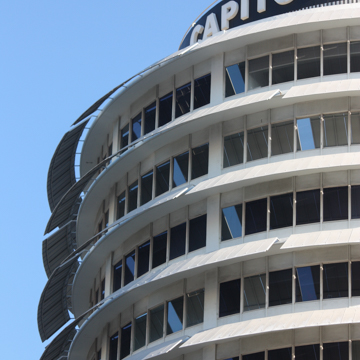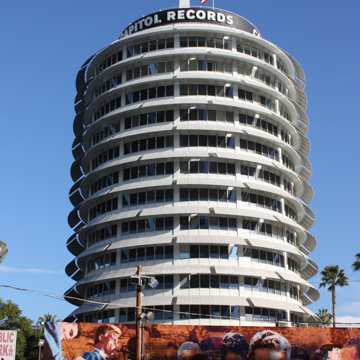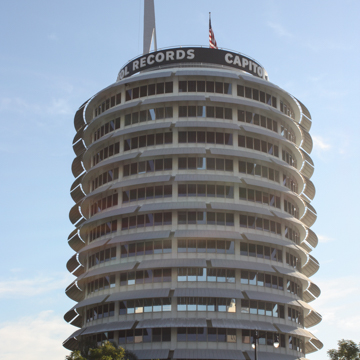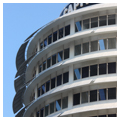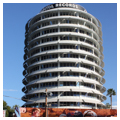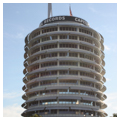The Capitol Records Tower is arguably Los Angeles’s most iconic building. Located near the legendary intersection of Hollywood Boulevard and Vine Street, the thirteen-story building features an eighty-two-foot spire topped by a red aviation beacon that blinks H-O-L-L-Y-W-O-O-D in Morse code. It is the world’s first circular office building.
Before the tower’s opening in 1956, the Capitol Records recording studios were located on Melrose Avenue. Founded in 1942 by singer Johnny Mercer, music store owner Glenn Wallichs, and songwriter Buddy DeSylva, Capitol Records was the first major record label on the West Coast. The company grew quickly and signed popular artists including Stan Kenton, Jo Stafford, Peggy Lee, Mel Tormé, and Nat King Cole. Frank Sinatra was the first to record at the new building, and music legends including the Beatles and the Beach Boys followed. By the mid-1960s, Capitol Records was a powerhouse in the music industry. The building advanced the company’s identity and became an instant landmark.
Highly visible from the Hollywood Freeway, the Capitol Records Tower is one of the most recognizable designs by the prolific firm of Welton Becket and Associates. By the 1960s, the Los Angeles–based firm had grown to be the largest architecture office in the United States. The firm’s many notable designs include Parker Center (1955), the Cinerama Dome (1963), and the Music Center of Los Angeles County (1967). One of the most notable features of this midcentury modern office tower are the continuous wraparound sunshades made of porcelain enamel, which protect the office from excessive sunlight and glare. The earthquake-resistant, concrete-reinforced building featured the most advanced technical amenities of its time, including an automated elevator system.
It has been long rumored that the tower’s round design intentionally resembled a stack of records. In fact, project designer Louis Naidorf did not even know the identity of the client when he proposed the design. The real reasons behind the circular shape were far more pragmatic. The round shape required up to twenty percent less outer wall than a rectangular structure, saving on construction costs. The smaller amount of wall space also reduced heat loss and gain through the glass, making climate control easier and more affordable.
The building’s most striking innovation was the set of three recording studios underneath the tower, the first ever designed for high-fidelity recording. Guitar pioneer Les Paul helped design the underground reverberation chambers, and they have remained in high demand ever since. The musicians and the songs they recorded at Capitol Records are just as iconic as the building itself.
References
Hess, Alan. “Built by Becket.” L.A. Forum Issue 7: Late Moderns, 2010. Accessed January 21, 2016. http://laforum.org/.
Los Angeles Conservancy. “Capitol Records Tower.” Accessed January 20, 2016. https://www.laconservancy.org/.
Los Angeles Conservancy Modern Committee. Built by Becket. Tour booklet, 2003.
Paul, Daniel. “The Capitol Tower.” Nomination for City of Los Angeles Historic-Cultural Monument, 2006.








